Challenges and Institutional Barriers to Forest and Landscape Restoration in the Chittagong Hill Tracts of Bangladesh
Abstract
:1. Introduction
2. Materials and Methods
2.1. The Study Area
2.2. Data Sources
- i.
- Relevance to our research objectives;
- ii.
- Geographical focus, i.e., CHT;
- iii.
- Related to “forest and landscape restoration” and its potential;
- iv.
- Publication year between 2000 and 2023;
- v.
- Peer-reviewed article.
- i.
- Sources not directly contributing to our study objectives;
- ii.
- Sources related to geographical regions other than the CHT;
- iii.
- Sources in languages other than English.
3. Findings
3.1. Present Institutional Arrangements in the CHT
3.2. Challenges in Current Institutional Arrangements in the CHT
3.3. Challenges to Forest and Landscape Restoration in the Chittagong Hill Tracts Region
4. Discussion
4.1. FLR’s Potential Benefits in the CHT
- i.
- Social Benefits
- ii.
- Environmental Benefits
- iii.
- Economic Benefits
4.2. Modalities for FLR Implementation in the CHT
4.3. Financing for FLR in the CHT
5. Conclusions
Supplementary Materials
Author Contributions
Funding
Institutional Review Board Statement
Data Availability Statement
Acknowledgments
Conflicts of Interest
References
- Mukul, S.A.; Biswas, S.R.; Rashid, A.Z.M.M.; Miah, M.D.; Kabir, M.E.; Uddin, M.B.; Alamgir, M.; Khan, N.A.; Sohel, M.S.I.; Chowdhury, M.S.H.; et al. A new estimate of carbon for Bangladesh forest ecosystems with their spatial distribution and REDD+ implications. Int. J. Res. Land-Use Sustain. 2014, 1, 33–41. [Google Scholar]
- Biswas, A.; Alamgir, M.; Haque, S.; Osman, K.T. Study on Soils under Shifting Cultivation and Other Land Use Categories in Chittagong Hill Tracts, Bangladesh. J. For. Res. 2011, 23, 261–265. [Google Scholar] [CrossRef]
- Ahammad, R.; Hossain, M.E.; Sobhan, I.; Hasan, R.; Biswas, S.R.; Mukul, S.A. Social-Ecological and Institutional Factors Affecting Forest and Landscape Restoration in the Chittagong Hill Tracts of Bangladesh. Land Use Policy 2023, 125, 106478. [Google Scholar] [CrossRef]
- Ahammad, R.; Stacey, N.; Sunderland, T.C.H.; Sangha, K.K. Land Use Preference for Ecosystem Services and Well-Being in Chittagong Hill Tracts of Bangladesh. Forests 2022, 13, 2086. [Google Scholar] [CrossRef]
- Jhala, A.D. Farming and Eating in an Indigenous Asian Borderland: Histories of Botany, Agriculture, and Food in the Chittagong Hill Tracts, East Bengal. Glob. Food Hist. 2022, 8, 34–55. [Google Scholar] [CrossRef]
- Misbahuzzaman, K.; Smith-Hall, C. Role of Forest Income in Rural Household Livelihoods: The Case of Village Common Forest Communities in the Chittagong Hill Tracts, Bangladesh. Small-Scale For. 2015, 14, 315–330. [Google Scholar] [CrossRef]
- Rudra, S.; Islam, K.N.; Rahman, M.; Uddin, S.B. Medicinal Plant Diversity and Their Therapeutic Uses in Selected Village Common Forests in Chittagong Hill Tracts, Bangladesh. J. Herbs Spices Med. Plants 2020, 27, 83–107. [Google Scholar] [CrossRef]
- Rasul, G. Political Ecology of the Degradation of Forest Commons in the Chittagong Hill Tracts of Bangladesh. Environ. Conserv. 2007, 34, 153–163. [Google Scholar] [CrossRef]
- Uddin, S.N.; Hassan, M.A. Angiosperm Flora of Rampahar Reserve Forest under Rangamati District in Bangladesh. I. Liliopsida (Monocots). Bangladesh J. Plant Taxon. 2012, 19, 37–44. [Google Scholar] [CrossRef]
- Khan, M.; Aziz, M.A.; Uddin, M.J.; Saif, S.; Chowdhury, S.; Chakma, S.; Chowdhury, G.M.; Jahan, I.; Akter, R.; Myant, M.; et al. Community Conserved Areas in Chittagong Hill Tracts of Bangladesh; Wildlife Trust of Bangladesh: Dhaka, Bangladesh, 2012. [Google Scholar]
- Parveen, S.; Faisal, I.M. People versus Power: The Geopolitics of Kaptai Dam in Bangladesh. Int. J. Water Resour. Dev. 2002, 18, 197–208. [Google Scholar] [CrossRef]
- Mohaiemen, N.; Ahmed, H.S.; Islam, Z. Between Ashes and Hope: Chittagong Hill Tracts in the Blind Spot of Bangladesh Nationalism; Drishtipat Writers’ Collective: Dhaka, Bangladesh, 2010. [Google Scholar]
- Adnan, S. Migration, Discrimination and Land Alienation: Social and Historical Perspectives on the Ethnic Conflict in the Chittagong Hill Tracts of Bangladesh. Contemp. Perspect. Hist. Sociol. South Asia 2007, 1, 1–28. [Google Scholar] [CrossRef]
- Jamil, I.; Panday, P.K. The Elusive Peace Accord in the Chittagong Hill Tracts of Bangladesh and the Plight of the Indigenous People. Commonw. Comp. Politics 2008, 46, 464–489. [Google Scholar] [CrossRef]
- Mohsin, A. The Chittagong Hill Tracts, Bangladesh: On the Difficult Road to Peace; Lynne Rienner Publishers: Boulder, CO, USA, 2003. [Google Scholar]
- Islam, S.S. The Economics of Conflict in the Chittagong Hill Tract Region of Bangladesh. In The Political Economy of Conflict in South Asia. International Political Economy Series; Webb, M.J., Ed.; Palgrave Macmillan: London, UK, 2015; pp. 12–31. [Google Scholar] [CrossRef]
- Ara, F.; Khan, M.M.R. The Chittagong Hill Tracts Peace Accord: Promises and Performances. In Migration, Regional Autonomy, and Conflicts in Eastern South Asia; Ranjan, A., Chattoraj, D., Eds.; Palgrave Macmillan: Cham, Switzerland, 2023; pp. 293–317. [Google Scholar] [CrossRef]
- Panday, P.K.; Jamil, I. Conflict in the Chittagong Hill Tracts of Bangladesh: An Unimplemented Accord and Continued Violence. Asian Surv. 2009, 49, 1052–1070. [Google Scholar] [CrossRef]
- Thapa, G.B.; Rasul, G. Implications of Changing National Policies on Land Use in the Chittagong Hill Tracts of Bangladesh. J. Environ. Manag. 2006, 81, 441–453. [Google Scholar] [CrossRef] [PubMed]
- Roy, R.D. Land and Forest Rights in the Chittagong Hill Tracts; International Centre for Integrated Mountain Development (ICIMOD): Kathmandu, Nepal, 2002. [Google Scholar] [CrossRef]
- Hill, G.; Chakma, K. Muscular Nationalism, Masculinist Militarism: The Creation of Situational Motivators and Opportunities for Violence against the Indigenous Peoples of the Chittagong Hill Tracts, Bangladesh. Int. Fem. J. Politics 2022, 24, 519–543. [Google Scholar] [CrossRef]
- Mamtaz, S.; Murshed, M.M.; Asaduzzaman, M.; Islam, M.N. Risks and Adaptation Strategies for Climate Change: A Community-Based Assessment Study in the Chittagong Hill Tracts of Bangladesh. In Bangladesh I: Climate Change Impacts, Mitigation and Adaptation in Developing Countries; Springer: Berlin/Heidelberg, Germany, 2018; pp. 119–143. [Google Scholar] [CrossRef]
- Lecours, N.; De Almeida, G.E.G.; Abdallah, J.; Novotny, T.E. Environmental Health Impacts of Tobacco Farming: A Review of the Literature. Tob. Control 2012, 21, 191–196. [Google Scholar] [CrossRef] [PubMed]
- Butler, G.; Szili, G.; Tripura, K. Tourism Development and Post-Conflict Reconciliation in the Chittagong Hill Tracts, Bangladesh: A Community Capitals Framework Approach. Community Dev. 2023, 55, 85–101. [Google Scholar] [CrossRef]
- Ahmed, B.; Alam, S.M.R.A.; Ahmed, I.; Sammonds, P. The Anthropogenic Aggravation of Landslide Disasters in Bangladesh: Key Informants’ Perspectives. In Progress in Landslide Research and Technology; Springer International Publishing: Cham, Switzerland, 2023; pp. 385–401. [Google Scholar] [CrossRef]
- Alam, M.K. Traditional Ecological Knowledge on Non-Wood Forest Products Management and Biodiversity Conservation: A Focus on Chittagong Hill Tracts (CHTS), Bangladesh. In Non-Wood Forest Products of Asia; Springer International Publishing: Cham, Switzerland, 2022; pp. 41–69. [Google Scholar] [CrossRef]
- Islam, R.; Schech, S.; Saikia, U. Violent Peace: Community Relations in the Chittagong Hill Tracts (CHT) in Bangladesh after the Peace Accord. Confl. Secur. Dev. 2022, 22, 271–295. [Google Scholar] [CrossRef]
- Chazdon, R.L.; Gutierrez, V.; Brancalion, P.H.S.; Laestadius, L.; Guariguata, M.R. Co-Creating Conceptual and Working Frameworks for Implementing Forest and Landscape Restoration Based on Core Principles. Forests 2020, 11, 706. [Google Scholar] [CrossRef]
- Ota, L.; Chazdon, R.L.; Herbohn, J.; Gregorio, N.; Mukul, S.A.; Wilson, S.J. Achieving Quality Forest and Landscape Restoration in the Tropics. Forests 2020, 11, 820. [Google Scholar] [CrossRef]
- Baul, T.K.; Chowdhury, A.I.; Uddin, M.J.; Hasan, M.K.; Schmidt, L.; Nandi, R.; Nath, T.K. Diversity and Phytosociology of Natural Regeneration in a Sub-Tropical Forest of Chittagong Hill Tracts, Bangladesh: Implications for Conservation. J. Sustain. For. 2022, 41, 895–908. [Google Scholar] [CrossRef]
- Bhattarai, S.; Pant, B.; Laudari, H.K.; Rai, R.; Mukul, S.A. Strategic pathways to scale up forest and landscape restoration: Insights from Nepal’s Tarai. Sustainability 2021, 13, 5237. [Google Scholar] [CrossRef]
- Khan, M.A.S.A.; Uddin, M.B.; Uddin, M.S.; Chowdhury, M.S.H.; Mukul, S.A. Distribution and Status of Forests in the Tropic: Bangladesh Perspective. Proc. Pak. Acad. Sci. 2007, 44, 145–153. [Google Scholar]
- Hasan, S.S.; Sarmin, N.S.; Miah, G. Assessment of Scenario-Based Land Use Changes in the Chittagong Hill Tracts of Bangladesh. Environ. Dev. 2020, 34, 100463. [Google Scholar] [CrossRef]
- Rasul, G.; Thapa, G.B. Financial and Economic Suitability of Agroforestry as an Alternative to Shifting Cultivation: The Case of the Chittagong Hill Tracts, Bangladesh. Agric. Syst. 2006, 91, 29–50. [Google Scholar] [CrossRef]
- Sultana, R.; Irfanullah, H.M.; Selim, S.A.; Alam, M.S. Social-Ecological Vulnerability to Climate Change and Risk Governance in Coastal Fishing Communities of Bangladesh. Front. Mar. Sci. 2023, 10, 1174659. [Google Scholar] [CrossRef]
- Cottrell, E.; Whitlock, E.P.; Kato, E.; Uhl, S.; Belinson, S.; Chang, C.; Hoomans, T.; Meltzer, D.; Noorani, H.Z.; Robinson, K.A.; et al. Defining the Benefits and Challenges of Stakeholder Engagement in Systematic Reviews. Comp. Eff. Res. 2015, 5, 13–19. [Google Scholar] [CrossRef]
- Rasul, G.; Tripura, N.B.K. Achieving the Sustainable Development Goals in Chittagong Hill Tracts—Challenges and Opportunities; ICIMOD Working Paper: Lalitpur, Nepal, 2016. [Google Scholar] [CrossRef]
- Ahammad, R.; Stacey, N.; Sunderland, T. Analysis of Forest-Related Policies for Supporting Ecosystem Services-Based Forest Management in Bangladesh. Ecosyst. Serv. 2021, 48, 101235. [Google Scholar] [CrossRef]
- Giessen, L.; Sarker, P.K.; Rahman, S. International and Domestic Sustainable Forest Management Policies: Distributive Effects on Power among State Agencies in Bangladesh. Sustainability 2016, 8, 335. [Google Scholar] [CrossRef]
- Bangladesh Forest Department (BFD). Available online: https://bforest.portal.gov.bd/ (accessed on 28 August 2023).
- Nath, T.K.; Inoue, M.; Myant, H. Small-Scale Agroforestry for Upland Community Development: A Case Study from Chittagong Hill Tracts, Bangladesh. J. For. Res. 2005, 10, 443–452. [Google Scholar] [CrossRef]
- Ahammad, R.; Stacey, N. Forest and agrarian change in the Chittagong Hill Tracts region of Bangladesh. In Agrarian Change in Tropical Landscapes; CIFOR: Bogor, Indonesia, 2016. [Google Scholar] [CrossRef]
- Mohsin, A. The Chittagong Hill Tracts, Bangladesh. In The Emergence of Bangladesh; Khondker, H., Muurlink, O., Ali, A.B., Eds.; Palgrave Macmillan: Singapore, 2022; pp. 251–258. [Google Scholar] [CrossRef]
- Roy, R.C.K. Land Rights of the Indigenous Peoples of the Chittagong Hill Tracts, Bangladesh; IWGIA: Copenhagen, Denmark, 2000. [Google Scholar]
- Ashraf Ali, H.M.; Vallianatos, H. Indigenous foodways in the Chittagong Hill Tracts of Bangladesh: An alternative-additional food network. In Postcolonialism, Indigenity and Struggles for Food Sovereignty: Alternative Food Networks in Subaltern Spaces; Routledge: Oxfordshire, UK, 2016; pp. 34–56. [Google Scholar]
- Chowdhury, M.S. Survival under Threat: Human Rights Situation of Indigenous Peoples in Bangladesh; Asia Indigenous Peoples Pact: Chiang Mai, Thailand, 2014. [Google Scholar]
- Barua, S.K. Entrusted with Development, It Destroys Hills, Graveyard. The Daily Star. 4 March 2020. Available online: https://www.thedailystar.net/country/news/entrusted-development-it-destroys-hills-graveyard-1876486 (accessed on 20 November 2023).
- Chakma, M.; Hayat, U.; Meng, J.; Hassan, M.A. An Assessment of Landscape and Land Use/Cover Change and Its Implications for Sustainable Landscape Management in the Chittagong Hill Tracts, Bangladesh. Land 2023, 12, 1610. [Google Scholar] [CrossRef]
- Mukul, S.A.; Herbohn, J. The impacts of shifting cultivation on secondary forests dynamics in tropics: A synthesis of the key findings and spatio temporal distribution of research. Environ. Sci. Policy 2016, 55, 167–177. [Google Scholar] [CrossRef]
- Alahi, F. Khagrachhari Awaits Greater Connectivity, Trade as 42 New Bridges Set to Open. The Business Standard. 24 October 2022. Available online: https://www.tbsnews.net/bangladesh/khagrachhari-awaits-greater-connectivity-trade-42-new-bridges-set-open-519118 (accessed on 20 November 2023).
- UNPO. Chittagong Hill Tracts: Development Project Destroying Graveyards and Ancestral Agricultural Lands in the Bandarban District; UNPO: The Hague, The Netherlands, 2020; Available online: https://unpo.org/article/21784 (accessed on 20 November 2023).
- Chakma, S. When Development Gives Little and Takes All. The Daily Star. 24 August 2023. Available online: https://www.thedailystar.net/opinion/views/news/when-development-gives-little-and-takes-all-3401221 (accessed on 20 November 2023).
- The Daily Star. Brick Kilns Destroying the Environment. The Daily Star. 14 January 2018. Available online: https://www.thedailystar.net/editorial/brick-kilns-destroying-the-environment-1519318 (accessed on 20 November 2023).
- Khan, N.A.; Khisa, S.K. Sustainable land management with rubber-based agroforestry: A Bangladeshi example of uplands community development. Sustain. Dev. 2000, 8, 1–10. [Google Scholar] [CrossRef]
- OHCHR. UN Human Rights Office; OHCHR: Geneva, Switzerland; Available online: https://www.ohchr.org/ (accessed on 20 November 2023).
- New Age. Tourism Must Not Destroy Lives and Nature; New Age: Dhaka, Bangladesh, 2020; Available online: https://www.newagebd.net/article/121563/tourism-must-not-destroy-lives-and-nature#:~:text=TILL%20date%2C%20all%20the%20tourist,of%20people’s%20tears%20and%20sighs (accessed on 20 November 2023).
- The Business Standard. Unplanned Tourism Development Blamed for Conflicts in CHT Areas. The Business Standard. 3 December 2022. Available online: https://www.tbsnews.net/bangladesh/unplanned-tourism-dev-blamed-conflicts-cht-areas-544694 (accessed on 20 November 2023).
- Hossain, I. Mro People at Risk of Displacement as Sikdar Group Constructs Five Star Hotel in Bandarban. Dhaka Tribune. 9 November 2020. Available online: https://www.dhakatribune.com/bangladesh/nation/229618/mro-people-at-risk-of-displacement-as-sikdar-group (accessed on 20 November 2023).
- Kumar, C.R.; Begeladze, S.; Calmon, M.; Saint-Laurent, C. Enhancing Food Security through Forest Landscape Restoration: Lessons from Burkina Faso, Brazil, Guatemala, Viet Nam, Ghana, Ethiopia and Philippines; International Union for Conservation of Nature: Gland, Switzerland, 2015. [Google Scholar] [CrossRef]
- Herbohn, J.; Ota, L.; Gregorio, N.; Chazdon, R.L.; Fisher, R.J.; Baynes, J.; Applegate, G.; Page, T.; Carias, D.; Romero, C.; et al. The Community Capacity Curve Applied to Reforestation: A Framework to Support Success. Philos. Trans. R. Soc. B 2022, 378, 1867. [Google Scholar] [CrossRef] [PubMed]
- Owusu, R.; Kimengsi, J.N.; Moyo, F. Community-Based Forest Landscape Restoration (FLR): Determinants and Policy Implications in Tanzania. Land Use Policy 2021, 109, 105664. [Google Scholar] [CrossRef]
- Di Sacco, A.; Hardwick, K.; Blakesley, D.; Brancalion, P.H.S.; Breman, E.; Rebola, L.C.; Chomba, S.; Dixon, K.W.; Elliott, S.; Ruyonga, G.; et al. Ten Golden Rules for Reforestation to Optimize Carbon Sequestration, Biodiversity Recovery and Livelihood Benefits. Glob. Chang. Biol. 2021, 27, 1328–1348. [Google Scholar] [CrossRef] [PubMed]
- Mukul, S.A.; Rashid, A.Z.M.M.; Uddin, M.B.; Khan, N.A. Role of non-timber forest products in sustaining forest based livelihoods and rural households’ resilience capacity in and around protected area: A Bangladesh study. J. Environ. Plan. Manag. 2016, 59, 628–642. [Google Scholar] [CrossRef]
- Gasparinetti, P.; Da Silva Brandão, D.; Maningo, E.V.; Khan, A.; Cabanillas, F.; Farfan, J.; Román-Dañobeytia, F.; Bahri, A.D.; Ponlork, D.; Lentini, M.; et al. Economic Feasibility of Tropical Forest Restoration Models Based on Non-Timber Forest Products in Brazil, Cambodia, Indonesia, and Peru. Forests 2022, 13, 1878. [Google Scholar] [CrossRef]
- Indrajaya, Y.; Yuwati, T.W.; Lestari, S.; Winarno, B.; Narendra, B.H.; Nugroho, H.Y.S.H.; Rachmanadi, D.; Pratiwi; Turjaman, M.; Adi, R.N.; et al. Tropical Forest Landscape Restoration in Indonesia: A Review. Land 2022, 11, 328. [Google Scholar] [CrossRef]
- Muhammed, N.; Koike, M.; Sajjaduzzaman, M.; Sophanarith, K. Reckoning social forestry in Bangladesh: Policy and plan versus implementation. For. Int. J. For. Res. 2005, 78, 373–383. [Google Scholar] [CrossRef]
- Hyde, W.F.; Köhlin, G. Social Forestry Reconsidered. Silva Fenn. 2000, 34, 632. [Google Scholar] [CrossRef]
- Löfqvist, S.; Garrett, R.; Ghazoul, J. Incentives and Barriers to Private Finance for Forest and Landscape Restoration. Nat. Ecol. Evol. 2023, 7, 707–715. [Google Scholar] [CrossRef] [PubMed]
- WWF. Public Funding for Forest Landscape Restoration; WWF: Gland, Switzerland, 2022; Available online: https://wwf.panda.org/wwf_news/?6650941/Public-funding-for-forest-landscape-restoration (accessed on 20 November 2023).
- FAO. The Forest and Landscape Restoration Mechanism; Food and Agriculture Organization of the United Nations: Rome, Italy, 2020; Available online: https://www.fao.org/in-action/forest-landscape-restoration-mechanism/our-work/gl/finance/en/ (accessed on 20 November 2023).
- Solidaridad. Restoring Forest Landscapes through Ecotourism in Ghana—Solidaridad Network; Solidaridad Network: Utrecht, The Netherlands, 2020; Available online: https://www.solidaridadnetwork.org/news/restoring-forest-landscapes-through-ecotourism-in-ghana/ (accessed on 20 November 2023).
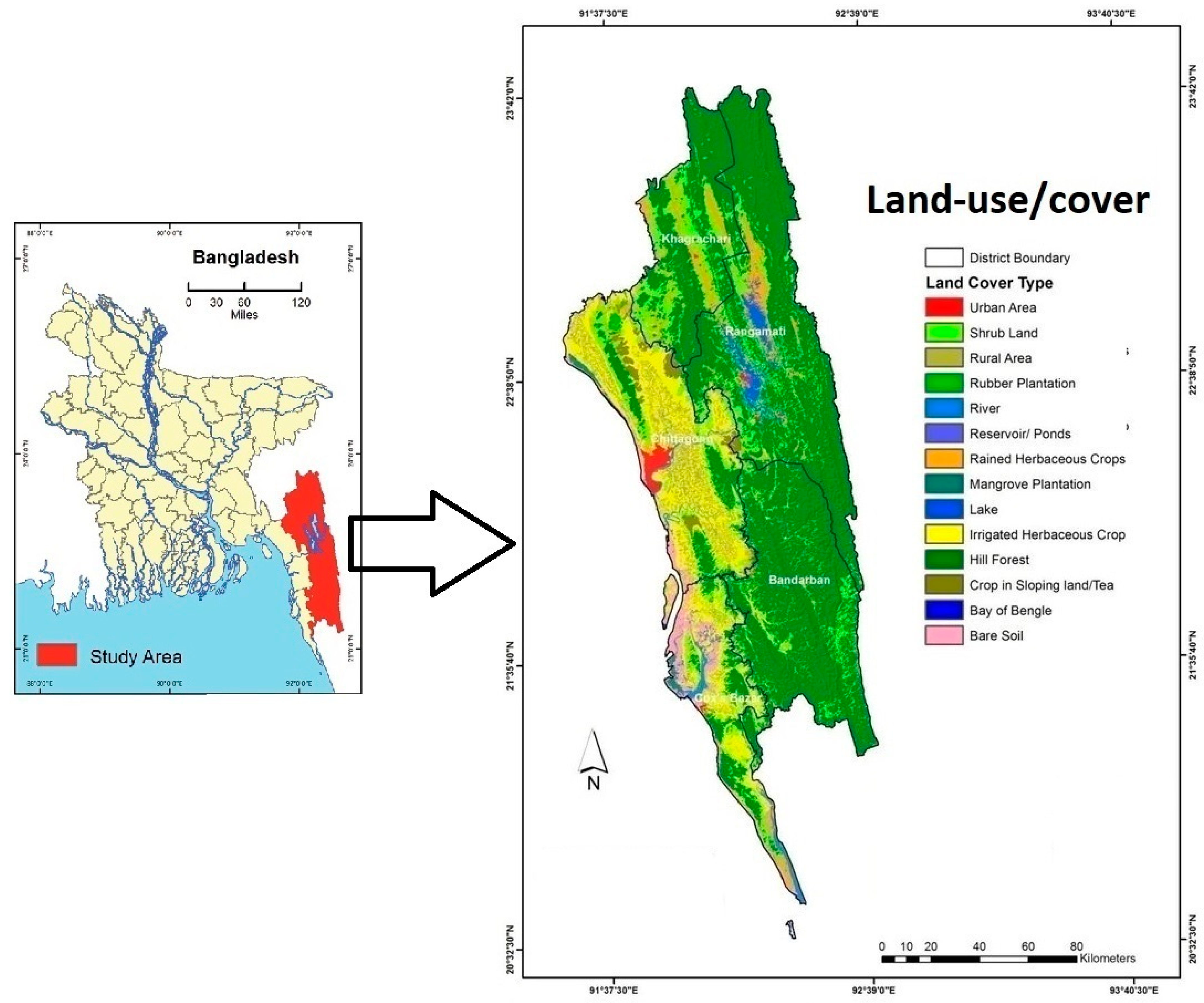
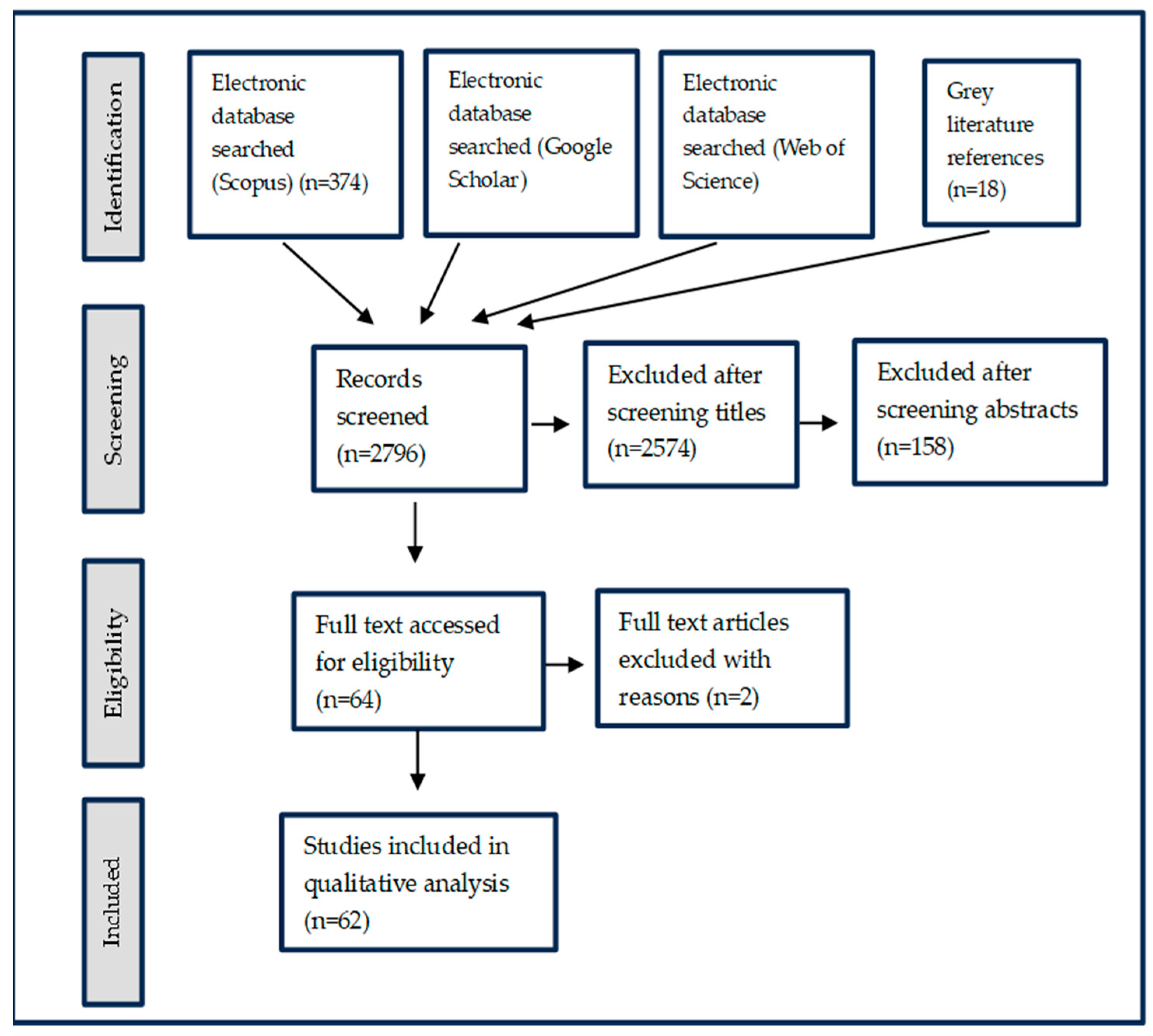
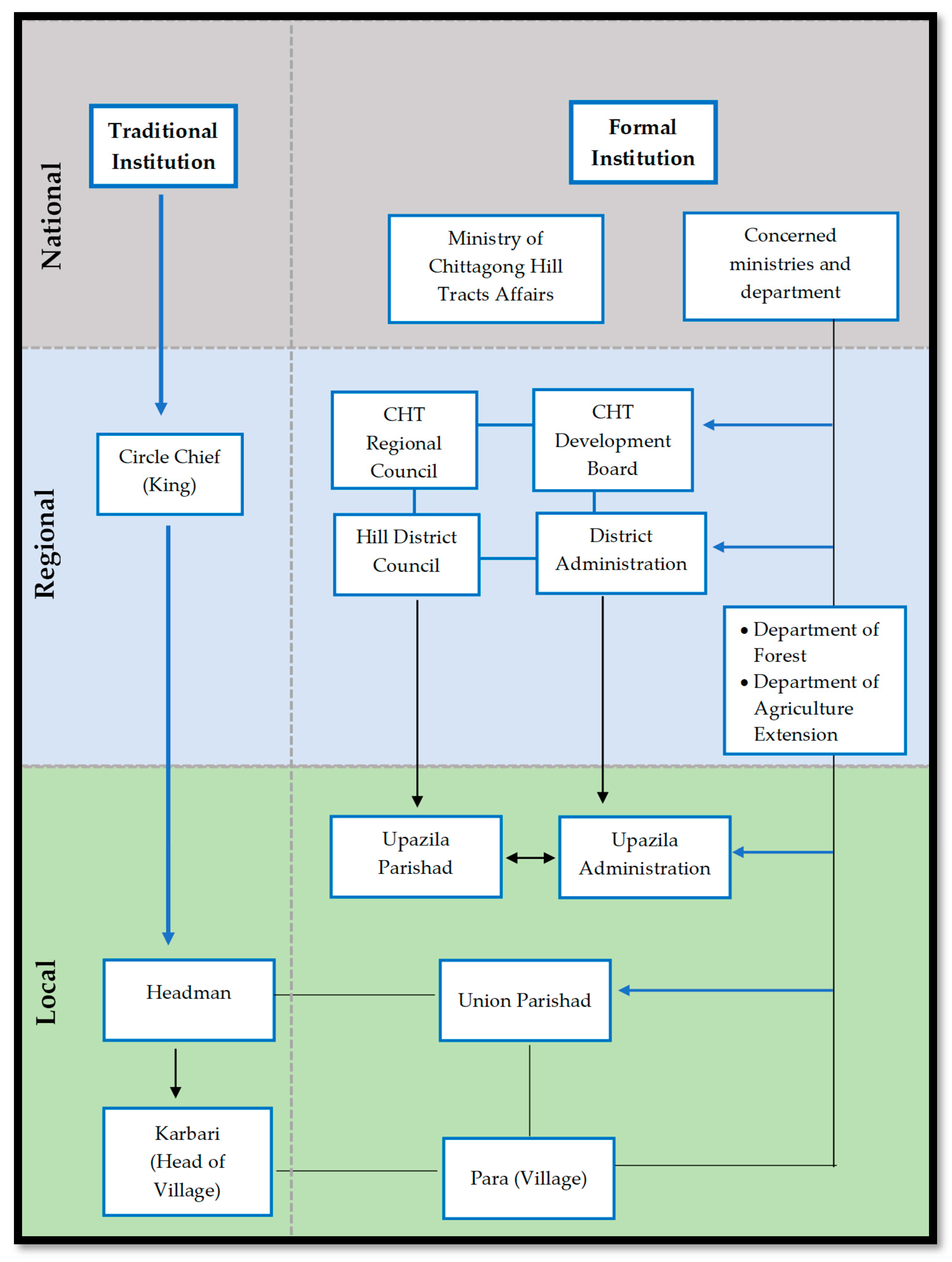


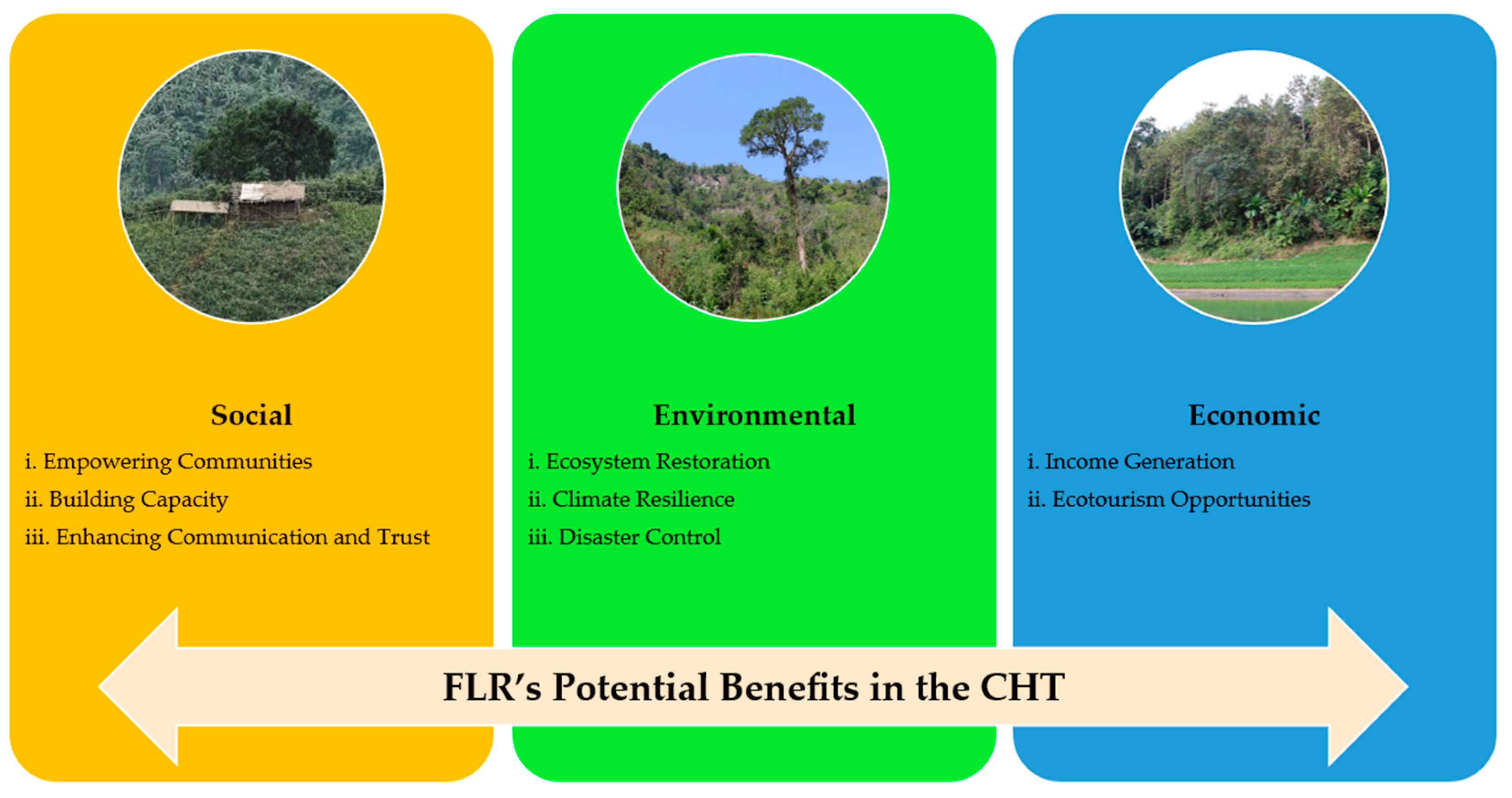
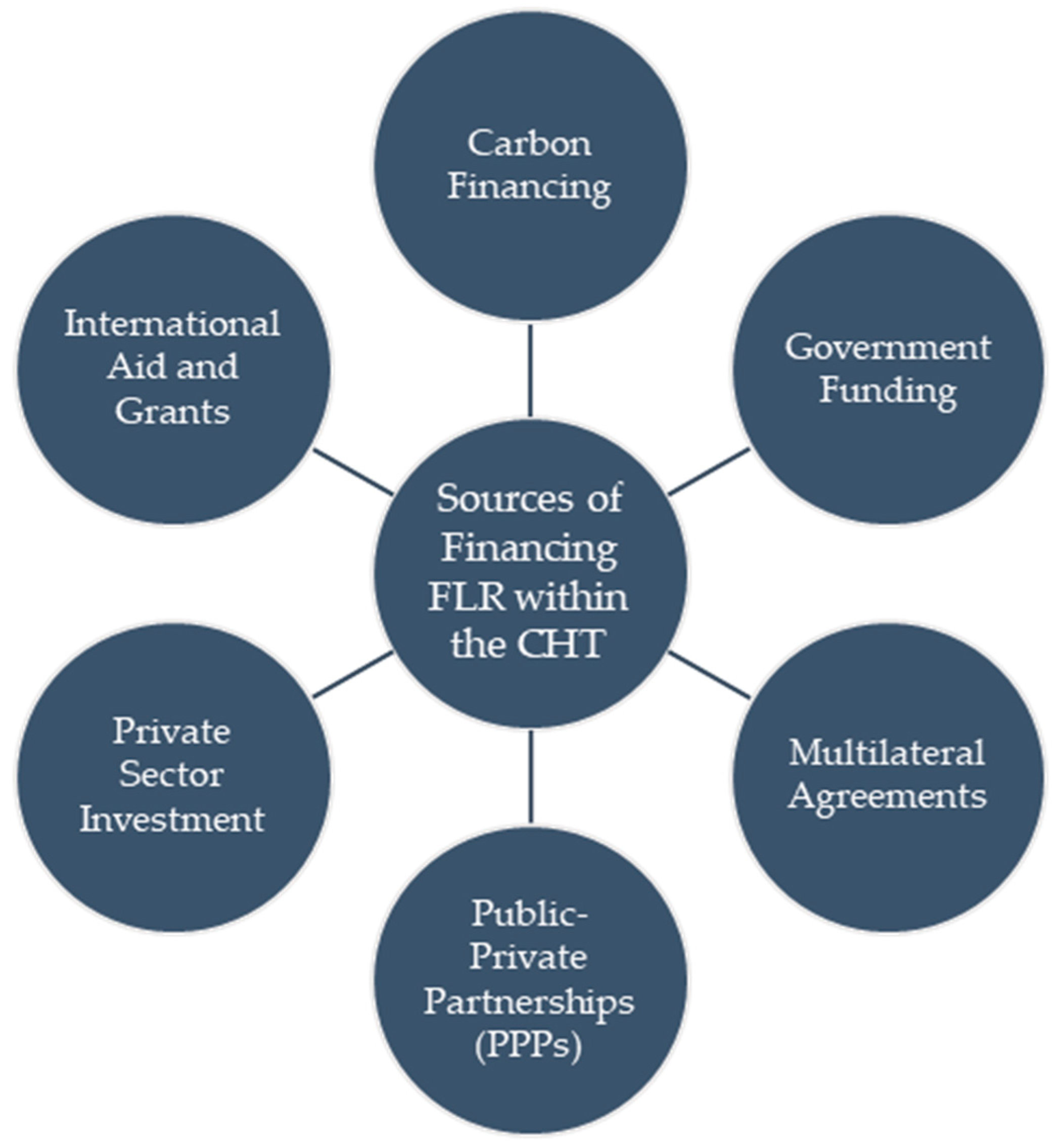
| District | Forests Managed by BFD | District Government-Controlled USF (ha) | Total Forest Land (ha) | |
|---|---|---|---|---|
| Reserved Forests (ha) | USF (ha) | |||
| Bandarban | 107,095 | 15,646 | 200,151 | 322,892 |
| Rangamati | 248,855 | - | 309,267 | 558,122 |
| Khagrachari | 38,800 | 1702 | 183,837 | 224,339 |
| Total forest | 394,750 | 17,348 | 693,255 | 1,105,353 |
Disclaimer/Publisher’s Note: The statements, opinions and data contained in all publications are solely those of the individual author(s) and contributor(s) and not of MDPI and/or the editor(s). MDPI and/or the editor(s) disclaim responsibility for any injury to people or property resulting from any ideas, methods, instructions or products referred to in the content. |
© 2024 by the authors. Licensee MDPI, Basel, Switzerland. This article is an open access article distributed under the terms and conditions of the Creative Commons Attribution (CC BY) license (https://creativecommons.org/licenses/by/4.0/).
Share and Cite
Sarkar, O.T.; Mukul, S.A. Challenges and Institutional Barriers to Forest and Landscape Restoration in the Chittagong Hill Tracts of Bangladesh. Land 2024, 13, 558. https://doi.org/10.3390/land13040558
Sarkar OT, Mukul SA. Challenges and Institutional Barriers to Forest and Landscape Restoration in the Chittagong Hill Tracts of Bangladesh. Land. 2024; 13(4):558. https://doi.org/10.3390/land13040558
Chicago/Turabian StyleSarkar, Oliver Tirtho, and Sharif A. Mukul. 2024. "Challenges and Institutional Barriers to Forest and Landscape Restoration in the Chittagong Hill Tracts of Bangladesh" Land 13, no. 4: 558. https://doi.org/10.3390/land13040558
APA StyleSarkar, O. T., & Mukul, S. A. (2024). Challenges and Institutional Barriers to Forest and Landscape Restoration in the Chittagong Hill Tracts of Bangladesh. Land, 13(4), 558. https://doi.org/10.3390/land13040558








